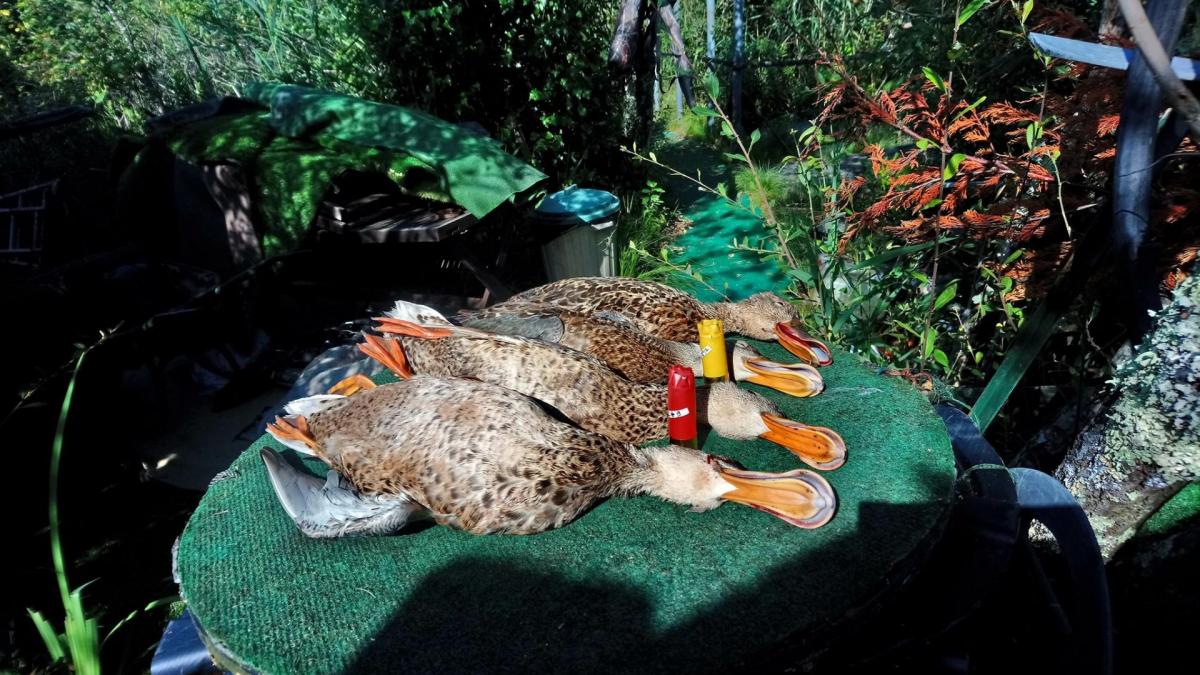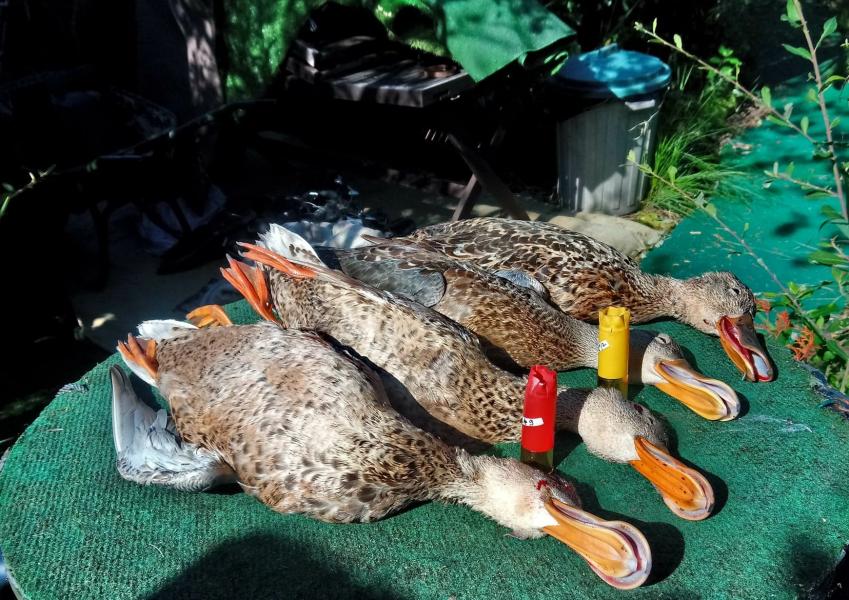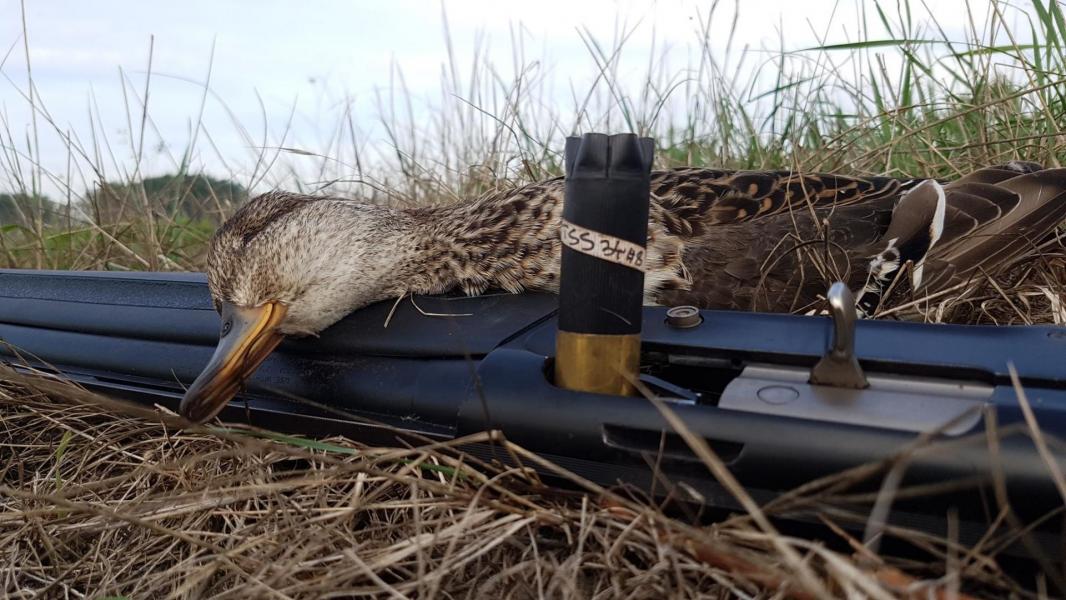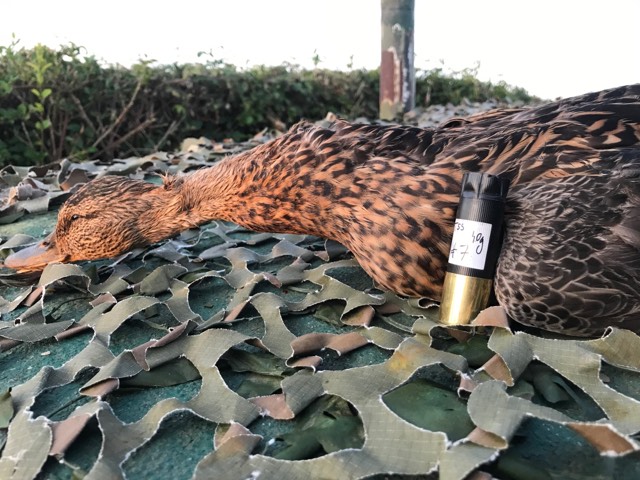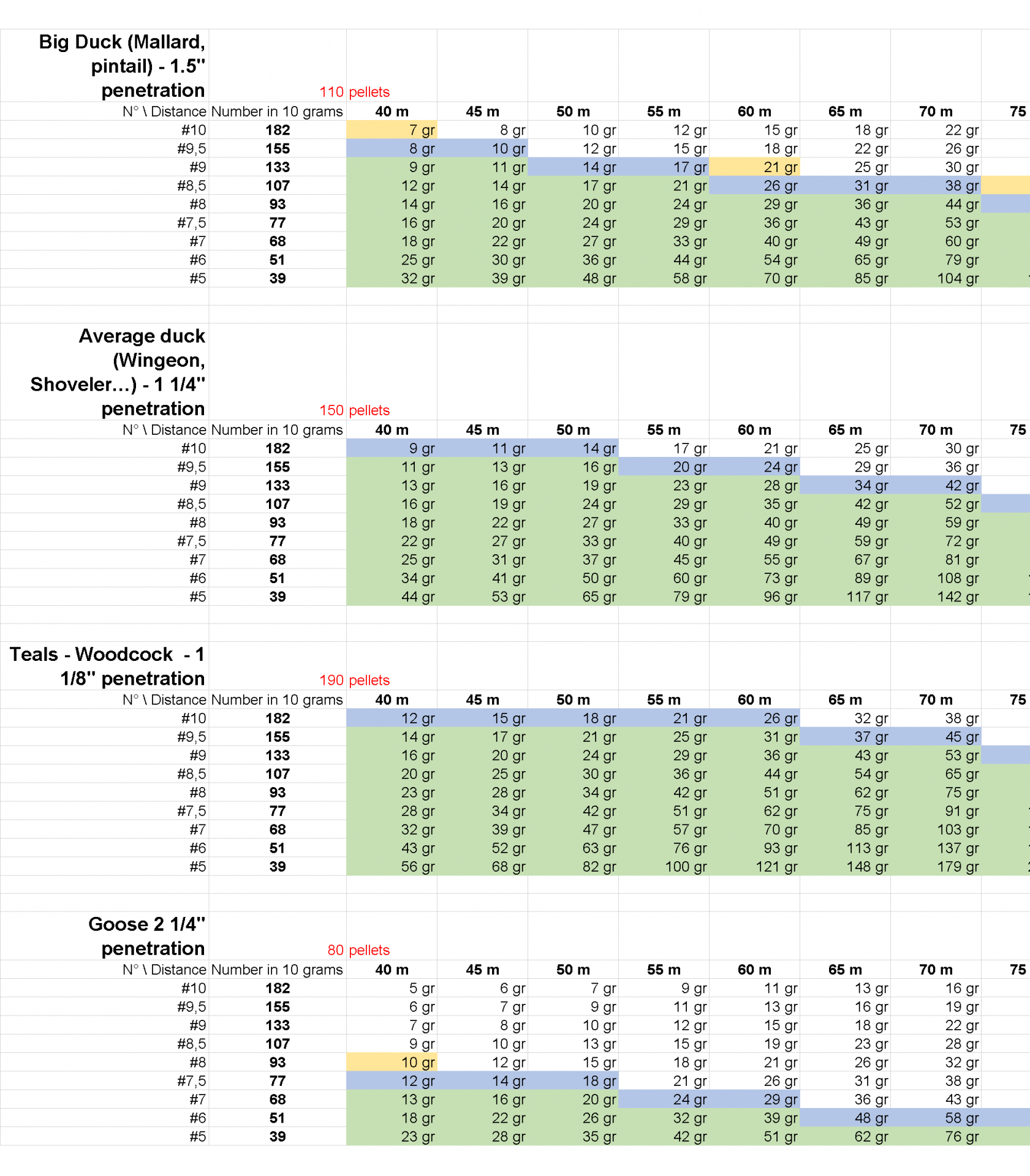TSS, the ultimate solution for long range shoot in wetlands!
Regarding the hunting of waterfowl, steel loads are often weak and must be used in adapted weapons and often magnum (76 mm) or even super magnum (89 mm) while some do not hesitate not even to go to gauge 10.
Waterfowl lovers of heavy loads and large caliber will soon be able to put away their "goose gun" and other 10-89. There is more comfortable and above all more effective than over-saturated loads of these shoguns.
It is from the USA that we have the substitute who will revolutionize the hunting of waterfowl. It's called TSS, like "Tungsten Super Shot".
The density helps small loads
So no, it's not steel but an alloy of tungsten, iron and nickel.
There are already excellent ammo loaded with tungsten beads. What is new?
Everything is a matter of density! While the steel has a density of 7.8 g / cm3, the tungsten that we offer in the current cartridges (Tungsteel, Sphero Tungsten, Ultimate, Xtended and so on) has a density included according to brands between 11.2 and 12.5 g / cm3. These densities are all slightly higher than lead and ammunition loaded with these pellets give very interesting results.
But the TSS boxing in a completely different category.
Its density is 18 g / cm3 or 2.3 times more than steel and it is at least 44% heavier than "commercial" tungsten.
And how is it really different?
It's pretty simple to understand. At equal mass, a TSS ball is much smaller than a steel ball. It is therefore braked much less quickly and keeps its speed longer. Its impact energy is therefore very important and above all, its penetration is much greater.
Penetration, the key lethal factor
The Americans, who have a much greater experience than Europeans in substitution munitions, have shown that penetration is the most important factor in the success of a shot.
Indeed, the ball may have a significant terminal energy, if it does not enter or little in the bird, it only hurts or at best knocked him out. Many examples go in this direction with birds that take the pattern of # 4 steel balls at 45 m and that leave as if nothing had happened. They must have large hematomas or even superficial injuries but nothing fatal. To take another picture, with the same hammer in the same board, a 4" nail will sink much less deeply than a glazier's small nail. It's exactly the same principle.
To kill properly, one pellet must reach a vital organ (brain, heart, liver, spine ...) and the balls must penetrate deep into the body of the bird. It is easy to understand that a penetration of a few millimeters is absolutely not deadly for most game animals.
In the USA, it is necessary to have a penetration of 1.5 '' (38 mm) for mallard and 2.25 '' (57 mm) for geese and this so that the blow is lethal.
TSS: small balls for extreme range
At this little game of penetration, the TSS is very, very strong. Steel # 2 (diameter 3.75 mm) gives a penetration to 48 m of 37.9 mm, which is the minimum necessary for the mallard. At 50 m, the TSS # 9 1/2 (1.9 mm) penetrates 45.2 mm and the TSS # 9 (2 mm) 50 mm. [1]
If we now compare the number of balls, a good 12-76 loaded with 36 g of #2 steel will send 167 balls. A 10-89 loaded with 46 g will send 214. These 167 balls of 12-76 correspond to 10.5 grams of TSS #9 1/2 or 12.6 g of TSS #9. The 214 balls have a 13.4 grams in TSS #9 1/2 and 16.1 grams in TSS# 9.
A 28-65 gauge (or even a 36) easily use these charges. In this sense, it is therefore more effective than a 10-89.
Are you not convinced ?
To give you more concrete examples, you can see below the photo of a follower who fired these first 32 g # 7 1/2 TSS ammunition on two Canada Geese - the first at 60 yards (54 m) and the second at 57 yards (52 m), both of which clean dead with projectiles almost all passed through the tissues.

Many users across the Atlantic also speak with humor of "dust" to talk about the TSS. They use #7½ or #8 for geese (Canada geese or snow geese) with amazing results. The #9½ is well adapted to ducks up to 50 m, with the #9 one can go up to 60 m.
Last season, some of my friends tried the TSS. He confirmed on the waterfowl of our countries what he has proven for many years in the United States. In particular, a test was particularly revealing on four geese shot at 60-65 m in January in "Authie Sud" Bay by 4 different shooters. The only one that remained clean killed, guess ... the one shot with TSS #7. Another remained wounded and the others left to be killed elsewhere.

The other duck killed that night have been with Duplex TSS #9 + Steel #2 loads for a total of 37 or 40 grams and a very acceptable cost price.
Long distance, the number of marbles makes the difference
So of course, at long distance, penetration is not everything. It is also necessary that the density of the pattern is good so that the number of impacts is sufficient to cause a mortal wound.
This is where the TSS also makes the difference for two reasons.
The first is that the TSS is a perfect sphere with an extremely smooth surface. The pellets do not deform and give a very tighten pattern close to 100%. [2]
The second reason is statistical. Indeed, a 36 gram of TSS #9 is loaded with 478 pellets ! This is the equivalent in number of marbles of 54 grams of #6 lead for example or 66 gram of #4 steel. This very high number of balls will necessarily increase the density of the pattern at long distance and thus increase the chance of reaching a vital organ.
While a high number of balls means heavy load with steel or lead and therefore slow speeds, the speed of the TSS can be high without overpressure, which enhances its effectiveness at long distance.
This is even the opposite because the height of the TSS ball column is lower than the one for lead, which reduces the friction and therefore the pressure.
OK, that's about steel. And compared to lead?
The results are almost as eloquent in comparing TSS to lead with a density of 11 g/cc. Despite the fact that lead is prohibited in wetland, it is still interesting to assess what the TSS can bring more.
Up to 40 m I shoot a 36 g of # 6
Yes, it's a classic. So if we analyze a 36 g of #6 lead (2.75 mm), the penetration of 38 mm is obtained at the maximum distance between 45 and 50 m. TSS # 9½ is already doing better. At the number of balls, there are about 300 #6 balls in a 36 grams load. To have the same number of balls, it is necessary to draw 19 grams of TSS #9 1/2 which is precisely the load of a 28-65 gauge.
For the leaded ultimate scopes and old duck hunters will not contradict me, we do not do much better than the 52 grams of #4. Indeed, with an initial speed of 380 m / s (which is already high for a magnum ammunition of this type), the penetration of 38 mm is reached at a little over 70 m. TSS # 9½ is exceeded. We should move to the TSS #8 1/2 which is very close or to #8 which outclasses it widely. Regarding the number of pellets, there are 263 #4 in this 52 grams load. This corresponds to 25 grams of TSS #8 1/2 or 28 grams of TSS #8.
Again, it is the 28 gauge that wins. It can rise to 24-25 g without any problem and therefore outperforms 12-76 lead.
In conclusion, the 20 - 22 grams of TSS #9 1/2 represent a deadly charge to hunt duck up to 50 m, 25 grams of TSS #8 1/2 up to 55 m and 32 grams of TSS #8 up to 60 m.
OK, but I already have a 12!
Of course, we do not have to switch to the 28 gauge to go hunting duck!
It is possible to draw 24 grams in 12 gauge. This is a load that is the equivalent in TSS #9.5 of 46 grams of lead #6 or 54 grams of steel #4, plus comfort.
And what are the disadvantages?
I'm not going to beat around the bush, the major disadvantage of this type of projectile is its cost. It costs 1.3 € the 10 grams!
That is to say that a 24 gram ammunition will come back to about 3 €. It's expensive but at the same time extremely effective.
There is another disadvantage but at the same time an advantage ... Let me explain: the ammunition loaded with TSS balls can never be packaged and sold in France. On the other hand, the TSS can be sold alone in order to be packaged by you.
And that's the benefit. For you can create your own ammunition according to your needs.
- Need ammunition to shoot geese far away : 32 grams or even 36 of # 7 ½ or # 7.
- You hunt over the decoys and look for a powerful second shot but still open, bet on Duplex TSS # 9 + steel # 4 which will be effective from 25 to 60 m for a moderate price.
- You are a snipe hunter with 20 gauge. Go to a TSS #9 ½ + steel #6 duplex that will also be able to drop any duck up to 50 m.
The number of possible combinations is infinite and can be adapted to all situations and all weapons.
The last disadvantage is the necessary precautions that must be taken to enclose this type of hard pellet.
As with steel, you can not use classical felt wads... You have to use the right type of wads to protect the barrel, the commercial steel wad doing the job more than adequate.
Don't worry, I have already developed the recipes that go well and I am at your disposal to eventually evolve as needed.
The real ultimate solution for the waterfowl
The TSS is therefore "THE" solution for the hunter of waterfowl who wishes to increase the current range of the ammunition of substitution, whatever they are. This is undoubtedly the best of today and for many years to come.
It is also today the only credible alternative to small caliber owners (less than or equal to 20 gauge) to hunt in the wetlands. With 18 or 20 g of TSS # 9 ½ or # 9, they will be able to catch the birds far away.
And if they go up a little, they will even have the satisfaction of having, with their fine weapon and 22 to 24 g of TSS, more power than the biggest magnum gauges, all with a recoil and unequaled comfort. What a pleasure to be finally able to bring out your 20 gauge shotgun for the waterfowl.
Another advantage, a single rifle is more than enough. Just fit the ammo, the 24 gram loads of TSS #9 and #9 ½ being the most versatile. Some 32 or 24 gram of #7 ½ or #8 in case there are geese and we can leave quiet.
To order
You can order on the store of this website the pellets. And for those who do not know how to reload, contact me and we will find a solution together.
[1] These results are derived from the use of software calculating as a function of initial velocity and for usual ranges, velocity and residual energy as well as penetration into gelatin.
[2] percentage of impacts found within a circle of 30 inches (76 cm) at 40 yards (36 m).
